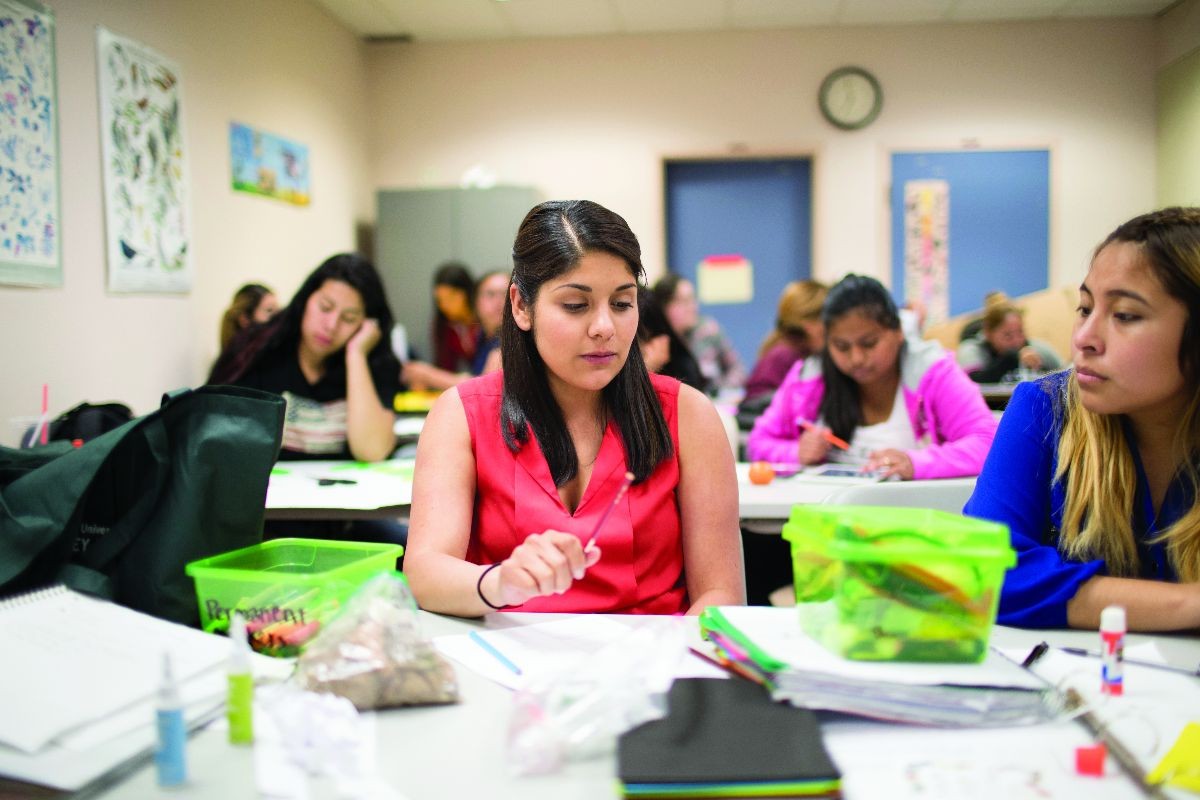CSUMB Magazine
Growing our own
Students enrolled in the visited CSUMB for the first time this fall and were welcomed by the men's and women's basketball teams and Monte Rey, the sea otter mascot.
The visiting students, all members of the second cohort of the new collaborative program with Hartnell College, are currently taking classes at the Hartnell College King City Education Center, but have access to resources and support at Hartnell and CSUMB.
What this means for our students is really an opportunity to change the trajectory of their life.— Antonio Gallardo, Teacher Pathway Program coordinator
“Going on a field trip to CSUMB to see the next step in our journey was like a sneak peek into our future,” said Sara Castro, a student in the program. “It was exciting, motivating and amazing to be able to think to myself: ‘So this is the next step; this will be where I go next; this will be me soon!’”
Professor Deedee Perez-Granados, Teacher Pathway Program coordinator who helped spearhead the program at CSUMB, said, “I’m excited about the because it is an opportunity to collaborate with Hartnell College and to support students who will become teachers in South Monterey County, where we have a huge need.”
Transformation
“One of the challenges is not only recruiting teachers but retaining teachers. And so one of the most effective ways to do that is to train our own. Grow our own teachers,” said Jose Luis Alvarado, dean of the College of Education at CSUMB.
“We’re tapping into local talent, but also every single one of these teachers then becomes role models for students who are currently in schools. It allows them to see and say, ‘Hey, there’s my aunt,’ ‘There’s my cousin who’s teaching now.’ And those young ones they are teaching will then aspire to go to college and we will begin to see a transformation of the entire community in South Monterey County.”
That local talent is being drawn from south Salinas Valley high schools including King City, Greenfield, Soledad and Gonzales.

Students in the program can take advantage of resources at both Hartnell and CSUMB, including tutoring, pre-professional workshops, priority registration, stipends, targeted academic advising and mentorship.
“So what this program is, it’s basically bringing the first two years of elementary education at Hartnell College, coupled with the last two years of upper division coursework at CSUMB, and offering a liberal studies B.A., followed by an additional year for the teaching credential,” Alvarado said.
The Teacher Pathway Program now serves a total of 62 students, all of whom are first-generation college students. It prepares them to make a significant and lasting impact on the quality of education that is afforded to youth in South Monterey County.
“There is a commitment for all participants to actually end up with teaching positions in South Monterey County,” Alvarado said.
“The Teacher Pathway Program so far has been a great experience,” said student Mayte Lomeli. “Having this cohort here for South County students helps encourage students to pursue their teaching major and helps those who can’t make it up to the main Hartnell campus.”
Growing demand
“In the first year of the CSUMB-Hartnell South Monterey County Teacher Pathway Program, we admitted a cohort of 21 students,” said Antonio Gallardo, Teacher Pathway Program coordinator at CSUMB. “Our second cohort for this year is up to 41 students. We’ve nearly doubled the number of students in the program in one year.”
“This is a testament to what institutions of higher education can collectively do to begin to address the critical shortage of credentialed teachers in Monterey County.”
We will begin to see a transformation of the entire community in South Monterey County— Jose Luis Alvarado, College of Education dean
Hartnell College and CSUMB have built the Teacher Pathway Program with an eye towards sustainability, ensuring this project continues to prepare fully qualified elementary and special education teachers well into the future.
“What this means for our students is really an opportunity to change the trajectory of their life. That’s on a very personal level,” said Gallardo. “So it’s really two-fold: it’s that personal thing that happens to you when you go to school when otherwise you might not have been afforded the opportunity. Many of our students are first-generation students and if it wasn’t for this program they wouldn’t have an opportunity to go to school at all.”
Gallardo said, “You can imagine what a labor of love this is for me because I was an unsuspecting high school graduate that had no dreams, no hope for going to college, and here I am decades later as the coordinator and professor to some of these students. That feels really good knowing there is a coordinated, official pathway.”
“Being in the Teacher Pathway Program has been an incredible experience. Not only do you get to meet new people but you are tremendously supported with Hartnell and CSUMB staff,” said student Nathalie Duran. “They are always there when you have questions or need further assistance with your path to becoming a teacher.”
Future
With the second cohort nearly doubling in number, the Teacher Pathway Program shows no signs of slowing down.
“We’re finding that we’ll probably end up having to adjust to suit the numbers of students that are requesting to come into this program,” explained Gallardo.
As successful as the Teacher Pathway Program is, approval from CSU Chancellor’s Office and the WASC Senior College University Commission is still pending.
Gallardo remains confident.
“I don’t think the program will go away. It’s got too much momentum at this point.”
Ever the visionary, Gallardo said, “We have an opportunity to put forth a model which meets the need for the critical shortage of teachers, but. . .wouldn’t the pathway model for community college students be great for any discipline?”